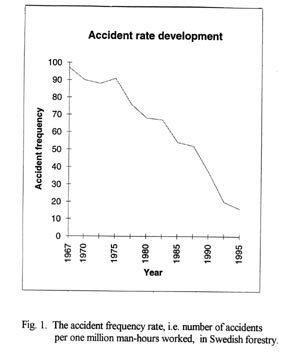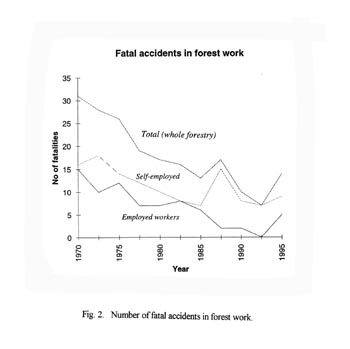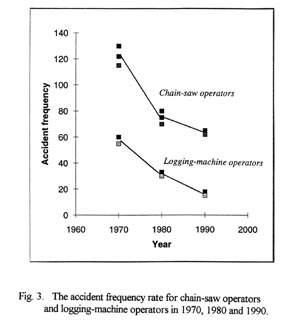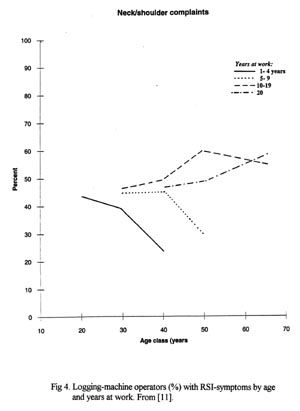
July, 1998, vol.9 no.2
Sven-Åke Axelsson
Swedish University of Agricultural Sciences
Uppsala, Sweden
The author is a Professor, Department of Operational Efficiency, Faculty of Forestry.
ABSTRACT
In this study the effect on occupational safety and health of increasing mechanization and improved ergonomics in Swedish forestry has been analyzed by using data on accidents and health hazards for chainsaw operators and logging-machine operators. In 1990 the accident frequency rate was 63 and 17 respectively, indicating a risk reduction of 73% by mechanization compared to chainsaw-based methods. There have also been significant improvements within each group. Between 1970 and 1990 the frequency rate for chainsaw operators was reduced by 48%, and for logging-machine operators by 70%, the result of improved ergonomics and safety organization. Health hazards have also been reduced, notably vibration-induced white fingers (VIWF) among chainsaw operators. The increasing number of machine contractors form a potential risk group. Some 50% of logging-machine operators have symptoms of repetitive stress injuries (RSI). Large-scale prevention programs have been initiated, with the emphasis on development of new work organization.
Keywords:Accidents, chainsaw operators, health hazards, logging-machine operators, mechanization.
INTRODUCTION
The introduction of the chainsaw and the mechanization of logging operations in Swedish industrial forestry have resulted in great changes of productivity and working conditions. Between 1960 and 1990 the total forest work productivity increased from 2.3 to 12.5 m3 per man-day. Off-road transportation was mechanized almost to 100% during the 1960s. Mechanization of felling operations in the industrial forestry has increased steadily since the beginning of the 1970s. Between 1970 and 1990, the degree of mechanization in final fellings increased from 25 to 85%, and in thinnings from practically zero to 60% [13].
The extensive mechanization and rationalization involved a radical decrease of the number of forest workers, and the occasional forest job changed to a full-time profession. The forest workforce has been reduced by 90% during the last 40 years, from 100,000 to 10,000, according to the Swedish Forest Workers' Union [5]. The chainsaw has been replaced by the harvester, a one-man technically sophisticated off-road machine, used for felling, delimbing, and crosscutting in one continuous operation, and also for final felling and thinning. The degree of utilization, per day and per year, is high. An average machine system consisting of a team of 4 to 5 operators in shift with one harvester and one forwarder produces some 40,000 m3 per year. In this advanced and expensive man/machine system the operator is sitting in the comfortable cab, designed according to ergonomic standards, activating the felling of trees with light movements of his fingers on the controls. The forest worker ´s heavy job has changed into a physically light, sedentary work, mentally demanding and with high economic pressure. The mechanization has been exceptionally far-reaching in Sweden. According to Joint FAO/ECE/ILO Committee, the degree of logging mechanization in Europe varies considerably, from 10% in some East European countries to 100% in some Scandinavian industrial forestry companies [8].
Simultaneously with the increasing mechanization in Swedish forestry, large-scale programs were undertaken to develop and improve the motor-manual work with chainsaws. To fell trees is a difficult and dangerous operation which requires adequate tools, training, and experience. The falling tree involves high, unpredictable forces. "Death caused by falling tree" is by far the most common explanation in the international fatal accident statistics in forestry. The chainsaw, with its unprotected chain running at a speed of some 20 m/sec, is a potentially dangerous tool. Technical/ergonomic improvements of the chainsaws were realized, the working technique was improved, and extensive training campaigns accomplished. Company safety organization, occupational health services, and ergonomic research were developed and international cooperation enlarged. This formed the background for the group of professional chainsaw operators who were well trained, equipped with tools meeting ergonomic standards, and possessed the required personal protective equipment. During the 1990s, this group has practically disappeared in large-scale forestry and has been replaced by machine operators.
Chainsaws continue to be widely used in private forestry in Sweden, however, by self-employed woodlot owners and occasional wood cutters. This is a large group of people with variable background and occupation, not exhaustively described in statistical terms. The total number of officially registered forest owners amounts to 240,000. The non-professional wood cutters with chainsaws, who are working on a self-employed basis without the support of any company safety organization and for very short working times of only some days or a couple of weeks per year, are exposed to high accident risks .
The objectives of this study were to analyse how the mechanization of logging operations in Swedish forestry has affected occupational safety and health, and to illustrate the influence of improved ergonomics, safety organization, and worker training.
MATERIALS AND METHODS
The level of safety and health cannot be exactly measured or quantified even for well defined branches or occupations, such as forestry or logging operations. On an international basis, differences in reporting systems on accidents and health hazards make it difficult and very uncertain to compare statistical data. Already in the 1950s the relevant international institution, the Joint FAO/ECE/ILO Committee on Forest Working Techniques and Training of Forest Workers [1], made the first attempt to coordinate the collection and analysis of statistics on safety and health. The participation of the International Labour Organization (ILO) has been of particular importance. The report series on occupational safety and health in forestry published by ILO [7], forms a valuable source of information on the state of the art.
In this study, three different, well-defined and separated groups in Swedish forestry were identified:
A) professional logging-machine operators,
B) professional chainsaw operators,
C) non-professional chainsaw operators.
A and B groups consist of full-time employed, professional workers, under the auspices of legal safety and health regulations and the employer's safety organization. This includes worker training, supply of required personal protective equipment, and machines and tools meeting ergonomic standards.
Group C consists mainly of untrained or poorly trained small private woodlot owners, forest farmers, and occasional wood cutters using chainsaws. Safety and health risks are caused by a lack of safety organization, short working time and consequent lack of experience, dangerous working practices, and insufficient personal protective equipment.
The official Swedish statistics include data on working hours, accidents, and fatalities in forest work in general, but not for specific groups, and not regarding health hazards [3]. Accident rates for groups A and B have been calculated for three years, 1970, 1980, and 1990, mainly by using data from the project "Coordinated work-injury statistics at larger forest companies" [15]. The project included registration of work injuries from 20 forest companies by a standardized method developed at the Department of Operational Efficiency. In addition, data on accidents have been utilized from the series "Work injuries in forestry", published by the forest employers' safety associations [2]. It has also been possible to use internal statistics not officially published from three larger forest companies in Northern Sweden, namely Domänverket, Mo and Domsjö and SCA. By way of example, for 1970 SCA reported 528 accidents among a total of 3400 employed forest workers. The number of accidents per 100 workers was 22.2 for chainsaw operators, 7.0 for logging-machine operators, and 2.7 for workers in silviculture [4].
For group C, non-professional chainsaw operators, the official statistics cannot be used for estimations of accident risks. Statistical data are acceptable only for employed workers. Fatal accidents, however, are recorded in a reliable manner. In order to get a better background, specific studies on accident prevention in this group have been carried out at the Department of Operational Efficiency [12]. The studies show that at most one third of all accidents in this group are being reported. Of 240,000 officially registered forest owners, approximately 133,000 performed self-employed forest work in 1987.
Data on health hazards have primarily been obtained from two sources: epidemiological studies, including medical examinations regarding work-related complaints and injuries; and studies of working conditions and machines, using ergonomic checklists for identifying risks in accordance with safety and health regulations and ergonomic standards. Occupational health services in Swedish forestry have led to increased knowledge and information on the forest workers' health status, to early identification of new health risks, and to regular follow-up of new machines. The development of forest machinery from a technical and ergonomic point of view has been followed closely by the Joint FAO/ECE/ILO Committee. Standards for machine testing procedures and ergonomic requirements have been issued by the International Organization for Standardization, ISO [6].
RESULTS
When the chainsaw replaced the axe and the bowsaw in Swedish forestry during the 1950s and 60s, this resulted in considerably increased productivity, but neither led to obvious improvements of safety and health nor to reduced work loads. Accident risks remained at a high level and even increased during the 1960s. In the peak year of 1967, more than 11,000 accidents and 38 fatalities occurred. Seventy per cent occurred during chainsaw work, notably kickback accidents during delimbing. New health hazards were introduced, mainly due to high levels of noise and vibration.
Between 1970 and 1990 the number of accidents per year steadily decreased from 8656 to 1469, and the corresponding amount of man-hours worked from 96 to 41 million. The accident risk, expressed as accident frequency rate, was reduced from 90 to 35 accidents per one million man-hours worked (Figure 1). The total volume of wood harvested remained fairly constant at 65 to 70 million m3 per year. Fatal accidents in forest work decreased from 31 to 14 per year between 1970 and 1995 (Figure 2). The figure shows that the fatal accidents have been steadily reduced for employed workers during the period; for self-employed, however, the number of fatalities remains relatively unchanged with an average of 10 per year. The fatal accidents occurred mainly during felling with chainsaws.


Group A: Professional logging-machine operators
Between 1970 and 1990, the average accident frequency rate for professional logging-machine operators was reduced from 58 (±3) to 17 (±2), corresponding to 70% (Figure 3). At the beginning of the mechanization, accident risks were particularly high during maintenance (i.e., repair and service) in the field. Studies during the 1970s indicated that the accident rate was even higher than for chainsaw operators [10]. Most accidents occurred when operators slipped and fell when climbing onto and working on the machine. Accident risks have been reduced by improved machine reliability and maintainability, including permanently lubricated bearings, automatic lubrication systems on tree booms, and by provision of slip-proof surfaces. Serious risks, however, are still caused by unintentional activation of photoelectric cells and switches. Accidents in mounting and descending have been practically eliminated through the provision of footsteps and handles.
Noise levels have been reduced from above 95 dB(A) to below the hearing risk limit 80 to 85 dB(A); the design of the cab and the workplace has been improved to ergonomic standards with adjustable seat and controls; new electric-hydraulic controls have been introduced; and whole-body vibration has been reduced below established ISO exposure limits. Progress has also been made in substituting mineral motor and hydraulic mineral oils by biological oils.
The specialized logging-machine operator is sitting many hours per day inside the cabin, working mostly with his arms and hands, with a high degree of concentration on the job, which has led to new health risks. Repetitive Stress Injuries, RSI, well known from modern industry work, are characterized by complaints and injuries to the neck, shoulder, arms, and cervical spine. Even very light, short-cycle movements of hands and arms may cause RSI-symptoms, and with prolonged exposure lead to injuries.


From [11].
Several studies with health examinations of logging-machine operators show that about 50% have more or less serious RSI-symptoms [11,17]. This is illustrated in Figure 4, which shows the result of a study of 1174 logging-machine operators, where 27 to 60% exhibited RSI-symptoms by age and years at work.
Group B: Professional chainsaw operators
Between 1970 and 1990 the average accident frequency rate for professional chainsaw operators was reduced from 122 (±8) to 63 (±3), corresponding to 48% (Figure 3). During this period a series of training courses in working techniques were carried out, company safety organizations were further developed, and the chainsaw was significantly improved from a safety and ergonomic point of view. Kickback injuries were reduced particularly through front-handle guards and chain brakes, which have become a standard feature today [6]. Personal protective equipment was developed, and its use enforced.
Vibration induced white fingers (VIWF) has been practically eliminated as a health hazard by technical improvements and anti-vibration systems; in 1967 the VIWF-prevalence figures were 38 to 58% (depending on age) for forest workers in northern Sweden [9]. Noise levels have been reduced from 110 to 95 dB(A). The risk of hearing impairment remains, however, and hearing protection continues to be a crucial issue. Biological instead of mineral oils are being used for lubrication, and catalytic converters have been introduced in order to reduce discomforts and possible health risks of exhaust gases.
Chainsaw work is still heavy even with modern chainsaws with reduced weight (5 to 8 kg). The work involves handling and lifting timber, in which unfavourable working positions often cannot be avoided. Musculo-skeletal complaints, notably lower back problems, are frequent. Chainsaw work under normal conditions in Swedish forestry requires an oxygen uptake capacity of 3.0 litre O2/min, which means that the operator's aerobic capacity will be a limiting factor, especially with increasing age. The relation between high aerobic working capacity and high performance in chainsaw work has been well established [14].
Group C: Non-professional chainsaw operators
Two measurements independent of each other in 1983 and 1987 indicate that the total number of accidents amounts to at least 2300 to 2500, at 20 million working hours and a total cut of 15 million m3 per year [13]. This corresponds to an accident frequency rate of 125. The accuracy of this figure is limited due to the low reliability of the statistics. Compared with the frequency rate of 17 for logging-machine operators, the risk level is approximately seven times higher.
DISCUSSION
Between 1970 and 1990 the accident frequency rate for group A (logging-machine operators) has been reduced from 58 to 17, or by 70%, and for group B (chainsaw operators) from 122 to 63, or by 48% (Figure 3). This substantial reduction of accident risks, 48 to 70%, has been achieved by improved ergonomics, safety organization and worker training. These factors cannot be distinguished.
The effect of the mechanization on the risk level, i.e., of the change from motor-manual chainsaw work to mechanized logging, can be illustrated by comparing groups B and A. In 1990 the accident frequency rate for chainsaw operators was approximately four times higher than for logging-machine operators (63 compared with 17), which indicates a risk reduction of 73% by mechanization. The total effect of mechanization together with improved ergonomics between 1970 and 1990 can be illustrated by the reduction of accident frequency rates from 122 to 17.
Although the statistics are uncertain for group C (non-professional chainsaw operators), the results confirm that accident risks and fatalities continue to be unsatisfactorily high. It is interesting to note that the frequency rate of 125 in 1990 is at the same level as the 122 recorded for professional chainsaw operators in 1970. Information and training campaigns are the main accident preventing activities. The practical problem is to reach out to the individuals of this large and diverse group.
Logging-machines are increasingly run by contractors in Swedish industrial forestry. In 1985/86 only 32% of the machines were owned by contractors. This figure had increased to 70% in 1992/93, and is predicted to increase further to 79% in 1997/ 98. The rest of the machines are owned by the forest companies. Health investigations of machine contractors do not unveil significant differences or clear tendencies compared with company employed machine operators. The contractors, however, form a potential risk group due to the uncertain economic conditions, long working hours, and difficulties to introduce modern work organization. Very few of the contractors work only 40 hours per week; more than half, notably single contractors, exceed 50 hours, and the average figure was as high as 58.6 work-hours per week [16].
The reduction of accident risks in forest work has been substantial and unambiguous. For health hazards the conclusion is more complex. New risks are emerging with mechanization. Some fifty per cent of the logging-machine operators have symptoms of RSI. This is by far the most serious health problem in Swedish forestry during the 1990s, and has led to extensive prevention programs. The development of a new work organization is needed, with work enlargement, job rotation, and changed working hours during the shift. The purpose is twofold: to reduce the risks of RSI by limiting the operator ´s exposure time inside the cab, and to simultaneously create good conditions for increased productivity. This includes development of new models for payment systems, aiming at ensuring the safety and stability of the individual operator and of the team and at giving motivation and incentive for improving work productivity and quality [11]. In studies of logging-machine operators, high levels of mental work load have been recorded, particularly in thinning. The importance of cognitive ergonomics will increase in the future development of logging machines.
ACKNOWLEDGEMENTS
The author wishes to thank the Joint FAO/ECE/ILO Committee on Forest Technology, Management and Training; and the ISO Technical Committee Tractors and Machinery for Agriculture and Forestry, SC 17 Manually Portable Forest Machinery, for valuable cooperation.
REFERENCES
[1] Anonymous. 1958. The collection, compilation and analysis of forest accident statistics. UN Publications. Geneva: Joint FAO/ECE/ILO Committee. FAO/ECE/LOG/29.
[2] Anonymous. 1967 -1990. Rapport över arbetsskador i skogsarbete, publicerade årligen i "Säkerhet". FSA och SYN. [In Swedish].
[3] Anonymous. 1970 -1996. Statistical Yearbook of Forestry. Official Statistics of Sweden. Skogsstyrelsen, Jönköping: National Board of Forestry.
[4] Anonymous. 1973. Årsrapport över arbetar-skydd med olycksfallsstatistik inom SCAs skogsbruk, Sundsvall. [In Swedish].
[5] Anonymous. 1987. Arbetsmiljörapport. Svenska. Skogsarbetareförbundet, Gävle. [In Swedish].
[6] Anonymous. 1988. Report of the 11th meeting of ISO/TC 23/SC 17 Manually Portable Forest Machinery. ISO, Rome, Italy. 14 p.
[7] Anonymous. 1991. Occupational safety and health in forestry. Geneva: ILO, Forestry and Wood Industries Committee. Report III. 71 p.
[8] Anonymous. 1994. Report from the 20th session of the Joint FAO/ECE/ILO Committee on Forest Technology, Management and Training. November, 1994. Thessaloniki, Greece.
[9] Axelson, S-Å. 1975. Progress in solving the problem of hand-arm vibration for chainsaw operators in Sweden. In: NIOSH Proceedings of the Intern. Occup. Hand-arm Vibration Conf., October 1975. Cincinnati. P. 218 -224.
[10] Axelsson, S-Å. 1981. Present situation and trends in occupational safety and health in highly mechanized logging in Europe. In: Environment Canada: Proceedings of the Joint FAO/ECE/ILO Committee seminar on highly mechanized logging operations, Ottawa. P. 89 -103.
[11] Axelsson, S-Å. and B. Pontén. 1990. New ergonomic problems in mechanized logging operations. Internat. Journal of Industrial Ergonomics 5 (1990): 267 -273.
[12] Engsås, J. 1993. Accidents in small-scale forestry. Dept. of Operational Efficiency, Swed. Univ. of Agri. Sciences. Res. Note 251. 121 p.
[13] Frej, J. and A. Tosterud. 1989. Systems and methods used in large scale forestry. Forest Operations Inst. of Sweden. Rep. No. 6. 24 p.
[14] Hansson, J-E. 1965. The relationship between individual characteristics of the worker and output of work in logging operations. Studia Forestalia Suecica No. 29. Stockholm. 90 p.
[15] Johansson, I. and B. Pontén. 1990. Coordinated work-injury statistics at larger forest companies. Dept. of Op. Eff., Swed. Univ. of Agri. Sciences. Res. Note 177. 37 p.
[16] Lidén, E. 1995. Forest machine contractors in Swedish industrial forestry. Garpenberg: Dept. of Operational Efficiency, Swed. Univ. of Agri. Sciences. Report 195. 43 p.
[17] Pontén, B. 1988. Health risks in forest work - A program for action. Garpenberg: Dept. of Operational Efficiency, Swed. Univ. of Agri. Sciences. Report 177. 81 p.